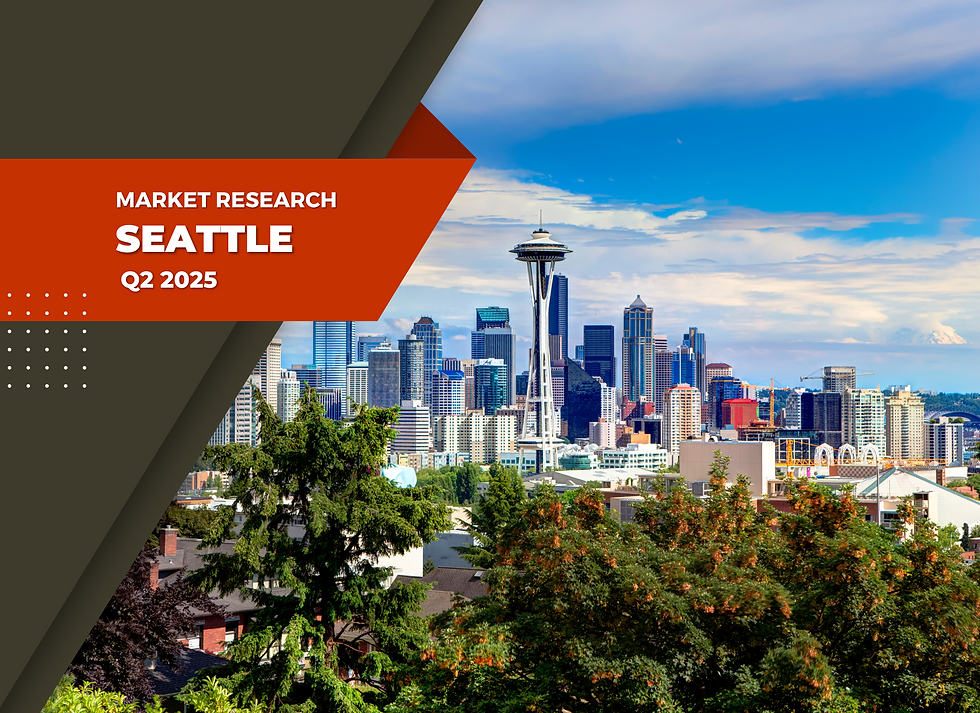Portland Q4 2024 Office Market Review: Is a Reset Coming?
- John Doe
- Feb 14
- 3 min read

Portland’s office market closed Q4 2024 with continued high vacancy rates, but leasing activity is showing signs of stabilization. While vacancy is at a high of 29.9%, leasing volume saw a 60% quarterly increase, signaling that companies are still investing in office space—but with more intentional, strategic decisions.
Even as tenants rethink their office footprints, demand continues shifting toward high-quality, amenity-rich spaces, while outdated properties struggle to compete. Looking ahead, Portland’s office market is at an inflection point, with landlords, tenants, and investors each facing critical decisions that will shape the future of the region’s workspace.
Vacancy & Availability: A Market in Transition
Portland’s office market ended Q4 2024 with a metro-wide vacancy rate of 21.7% and availability at 24.9%, reflecting both traditional vacancies and sublease listings.
CBD vacancy reached 28.5%, with Class A space hitting a record-high 39.6%.
Sublease space remains elevated at 2.3M SF, with tenants continuing to optimize footprints rather than fully exiting.
The vacancy-availability gap narrowed to 4.6%, suggesting that companies are stabilizing their space usage compared to previous quarters.
This data confirms what we’ve been hearing in the industry—tenants aren’t abandoning office space altogether, but they are making more strategic choices about how much space they need and how it’s designed. The old “one-size-fits-all” approach no longer works. Companies are optimizing their footprints, reducing excess space, and seeking higher-performing offices that support culture, collaboration, and employee experience.
Leasing Activity: Signs of Stabilization
Leasing rebounded in Q4, particularly in Class A and suburban submarkets:
192 leases over 1,000 SF were signed, a 60% increase from Q3.
Suburban markets outperformed downtown, with notable deals in Kruse Way, Tigard/I-5, and Beaverton/Sunset Corridor.
Companies are prioritizing flexible, high-quality office environments, aligning with the ongoing flight to quality trend.
While leasing volume is up, it’s still highly selective. The real winners here are buildings that offer something more than just office space—amenities, flexible lease terms, and well-designed common areas are what’s driving demand.
Rental Rates: Holding Firm Despite Vacancy Pressures
Although vacancy remains high, rental rates have remained stable across the metro:
CBD Class A asking rents averaged $39.60/SF, while suburban markets like Lake Oswego reached $42.10/SF.
Metro-wide asking rents averaged $33.61/SF, remaining flat from Q3.
Tigard/I-5/Highway 217 (+$3.96/SF YOY) and Suburban Vancouver (+$2.58/SF YOY) saw rental growth, demonstrating strong suburban demand.
The fact that rents are holding steady despite high vacancy tells us that landlords are hesitant to drop pricing, opting instead to compete in other ways—through concessions, tenant improvement allowances, and flexible lease structures. For tenants, this means negotiation opportunities exist, but landlords are prioritizing long-term leasing stability over short-term discounts.
Sublease Space: What It Means for the Market
Sublease space remains one of the biggest challenges for Portland’s office sector, with over 2.3M SF available in Q4. This has created:
More competition for direct leases, forcing landlords to differentiate through amenities and flexibility.
Opportunities for tenants to secure premium space at a discount, as sublease rates typically undercut direct leases.
Longer absorption timelines, meaning that even if demand increases, vacancy rates may take several quarters to stabilize.
The sublease market is a double-edged sword. On one hand, tenants seeking move-in-ready space at a discount have opportunities they wouldn’t have had a few years ago. On the other hand, it’s creating headwinds for direct leasing—meaning landlords of older properties need to rethink their value proposition if they want to stay competitive.
Portland vs. Other Major Markets
Portland’s high vacancy mirrors broader national trends, particularly in markets heavily impacted by hybrid work adoption:
San Francisco’s vacancy reached 31.6%, with a record level of sublease availability.
Seattle’s vacancy remains above 23%, with demand consolidating around core submarkets.
Denver continues to see companies reducing office footprints, prioritizing flexible lease terms.
Portland’s recovery timeline isn’t unique, but what’s important is how the local market adapts. Other cities have seen success by investing in mixed-use development, repositioning office buildings, and leaning into industry-specific growth sectors. How Portland reinvents itself will determine whether it follows a similar path.




Comments